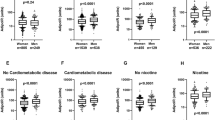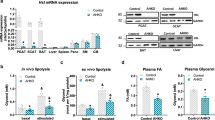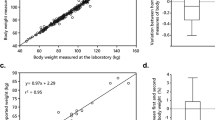Abstract
OBJECTIVE: To evaluate a possible influence of a hereditary trait for obesity on the regulation of adipocyte metabolism in vitro in subcutaneous fat cells in obese and non-obese subjects.
DESIGN: A biopsy from abdominal subcutaneous fat was obtained from consecutive subjects with or without a family trait for obesity. A positive family history of obesity was considered present if one or more of the first degree relatives had a BMI of 27 kg/m2 or more.
SUBJECTS: 67 non-obese and 60 obese subjects, age 19–60 y. A family trait for overweight was present in 42 of the lean subjects and in 50 of the obese subjects.
MEASUREMENTS: Fat cells were isolated and incubated in vitro with isoprenaline (a non-selective beta-adrenoceptor agonist), forskolin (activates the adenylyl cyclase) and dibutyryl cyclic AMP (stimulates the protein kinase hormone-sensitive lipase complex). Glycerol release was measured and used as lipolytic index.
RESULTS: Maximal lipolytic response per g triglycerides was about 50% lower in obese subjects both with and without a positive heredity and in non-obese subjects with a family trait for obesity as compared to non-obese subjects without such trait (P=0.0001). Fat cell volume was twice as high in obese as compared to lean subjects. Drug-induced maximal glycerol release per fat cell in the obese subjects, regardless of family history of obesity, reached a similar level, but did not exceed that of the lean group without heredity.
CONCLUSIONS: Obesity is associated with catecholamine resistance with a relatively ineffective lipolysis in fat cells, and presence of a family history of obesity was not associated with a further suppression of lipolysis. In the lean subjects, heredity for obesity significantly influenced lipolysis to similar low levels as in the obese subjects.
This is a preview of subscription content, access via your institution
Access options
Subscribe to this journal
Receive 12 print issues and online access
$259.00 per year
only $21.58 per issue
Buy this article
- Purchase on Springer Link
- Instant access to full article PDF
Prices may be subject to local taxes which are calculated during checkout


Similar content being viewed by others
References
Kuczmarski RJ, Flegal KM, Campbell SM, Johnson CI . Increasing prevalence of overweight among US adults: the National Health and Nutrition Examination Surveys, 1960 to 1991 JAMA 1994 272: 205–211.
Rosenbaum M, Leibel RL, Hirsch J . Obesity New Engl J Med 1997 337: 396–407.
Hill JO, Peters JC . Environmental contributions to the obesity epidemic Science 1998 280: 1371–1374.
Bouchard C, Pérusse L . Genetics of obesity A Rev Nutr 1993 13: 337–354.
Bouchard C, Tremblay A, Després JP, Nadcau A, Lupien PJ, Thériault G, Dussault J, Moorjani S, Pinault S, Fournier G . The response to long-term overfeeding in identical twins New Engl J Med 1990 322: 1477–1482.
Lafontan M, Berlan M . Fat cell adrenergic receptors and the control of white and brown fat cell function J Lipid Res 1993 34: 1057–1092.
Lönnqvist F, Krief S, Strosberg AD, Nyberg B, Emorine L, Arner P . Evidence for a functional beta3-adrenoceptor in man Br J Pharmacol 1993 110: 929–936.
Langin D, Holm C, Lafontan M . Adipocyte hormone-sensitive lipase: a major regulator of lipid metabolism Proc Nutr Soc 1996 55: 93–109.
Reynisdottir S, Wahrenberg H, Carlström K, Rössner S, Arner P . Catecholamine resistance in fat cells of women with upper-body obesity due to decreased expression of beta2-adrenoceptors Diabetologia 1994 37: 428–435.
Jensen MD, Haymond MW, Rizza RA, Cryer PE, Miles JM . Influence of body fat distribution on free fatty acid metabolism in obesity J Clin Invest 1989 83: 1168–1173.
Bouchard C . Genetic factors in the regulation of adipose tissue distribution Acta Med Scand 1988 723: 135–141.
Mauriège P, Després JP, Marcotte M, Tremblay A, Nadeau A, Moorjani S, Lupien P, Daussault J, Fournier G, Theriault G . Adipose tissue lipolysis after long-term overfeeding in identical twins Int J Obes 1992 16: 219–225.
Hellström L, Langin D, Reynisdottir S, Dauzats M, Arner P . Adipocyte lipolysis in normal weight subjects with obesity among first-degree relatives Diabetologia 1996 39: 921–928.
Bray GA . Overweight is risking fate. Definition, classification, prevalence and risks Ann NY Acad Sci 1987 499: 14–28.
Large V, Reynisdottir S, Eleborg L, van Harmelen V, Strömmer L, Arner P . Lipolysis in human fat cells obtained under local and general anesthesia Int J Obes 1997 21: 78–82.
Rodbell M . Metabolism of isolated fat cells. 1. Effects of hormones on glucose metabolism and lipolysis J Biol Chem 1964 239: 375–380.
Hirsch J, Gallian E . Methods for determination of adipose cell size and cell number in man and animals J Lipid Res 1968 9: 110–119.
Hellmér J, Arner P, Lundin A . Automatic luminometric kinetic assay of glycerol for lipolysis studies Anal Biochem 1989 177: 132–137.
Bouchard C, Pérusse L . Heredity and body fat A Rev Nutr 1988 8: 259–277.
Chagnon YC, Pérusse L, Bouchard C . Familial aggregation of obesity, candidate genes and quantitative trait loci Curr Op Lipidol 1997 8: 205–211.
Engfeldt P, Hellmér J, Wahrenberg H, Arner P . Effects of insulin on adrenoceptor binding and the role of catecholamine-induced lipolysis in isolated human fat cells J Biol Chem 1988 263: 15553–15560.
Acknowledgements
The study was supported by grants from Knut and Alice Wallenberg Foundation, The Swedish Medical Society, The Swedish Foundation for Strategic Research and the Karolinska Institute, Sweden.
Author information
Authors and Affiliations
Corresponding author
Rights and permissions
About this article
Cite this article
Hellström, L., Reynisdottir, S. Influence of heredity for obesity on adipocyte lipolysis in lean and obese subjects. Int J Obes 24, 340–344 (2000). https://doi.org/10.1038/sj.ijo.0801134
Received:
Revised:
Accepted:
Published:
Issue Date:
DOI: https://doi.org/10.1038/sj.ijo.0801134



